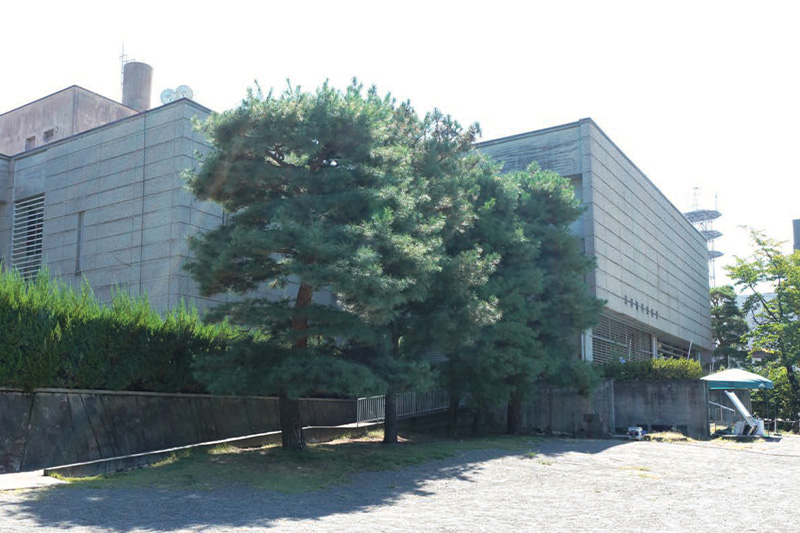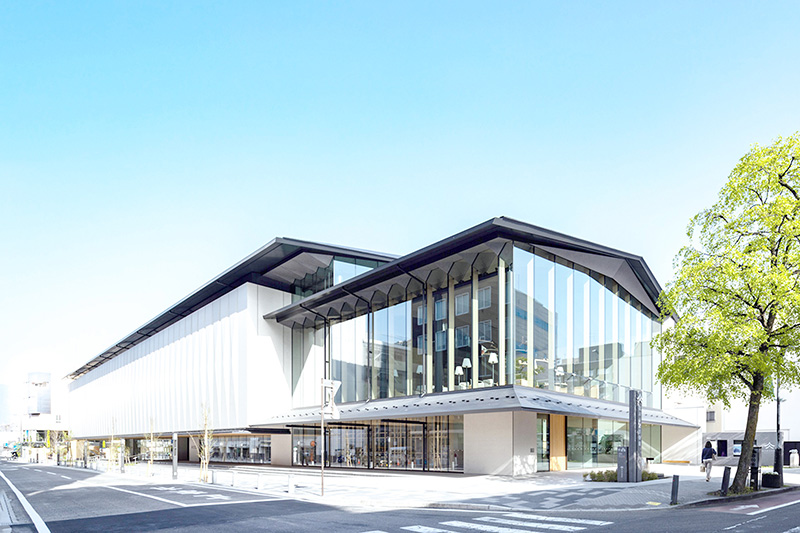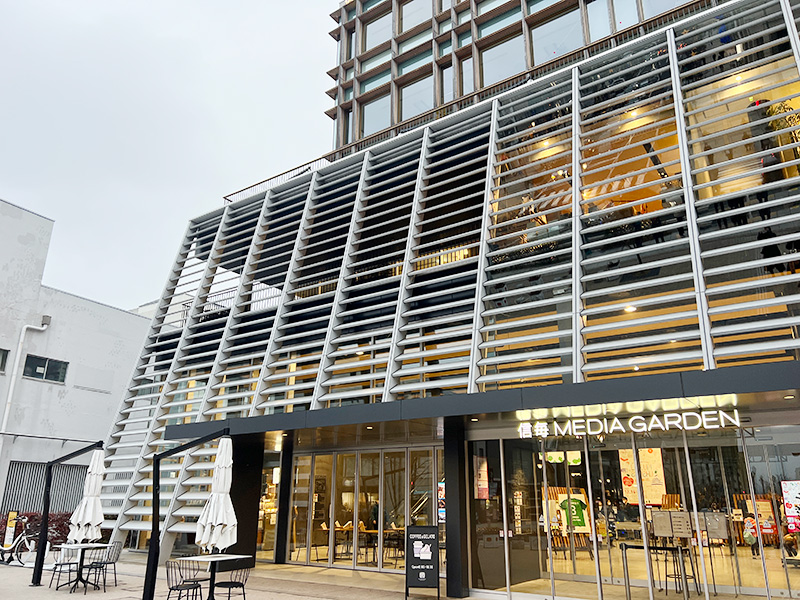VENUE

旧松本市立博物館
Matsumoto City Museum(old)
建築年 1967(昭和42)年
設計者 株式会社石本建築事務所
施工者 株式会社間組
1906(明治39)年に創立された「松本紀念館」を前身とする「松本市立博物館」は、1967(昭和42)年、松本城二の丸に新築され「日本民俗資料館」として開館した。当時は北信越東海地方で最大規模を誇り、〈先進的な博物館〉として他地域での建設計画の紹介事例に挙がるなど、地方都市の博物館を牽引する存在でもあった。収集と保存・調査研究・展示(社会教育)という3つの機能を備え、講堂や学芸員室など〈新しい博物館〉を体現する本格的な設備を有していた。
史跡地のため景観を損なわないよう、建物の高さやボリューム感、建築素材にも配慮が感じられる。斜めに配置したファザードや、花崗岩の砕石を洗い出しにした外壁は、松本城の石積みに呼応する。外壁の開口部(窓)にはプレキャストコンクリートのルーバーが設けられ、展示に支障のない形で自然光が取り込めるようになっている。
正面入口の上部は、開口部(窓)がない大きな壁面となっており圧迫感があるが、エントランスホールへ進むと開放的な空間が広がる。吹き抜けにはトップライトによる採光がとられ、自然光が降り注ぐ階段では地下へと誘われる。開館当初は陳列品が見やすいようにと、コバルト色の布地で壁面を覆っていたという。一階の南東には半屋内の庭があり、藩政時代を偲ぶ古井戸が遺されている。 博物館の移転が決定し、2021(令和3)年に休館。現在は解体に向け準備が進められている。
Year of construction: 1967 (Showa 42).
Architect: Ishimoto Architects
Builder: Hazama Corporation
The “Matsumoto City Museum”, which was founded in 1906 (Meiji 39) and was the predecessor of the “Matsumoto Memorial Museum”, was newly built in Matsumoto Joji no Maru in 1967 (Showa 42) and opened as the “Japan Folklore Museum”. At that time, it was the largest museum in the Hokushinetsu Tokai region, and as an “advanced museum”, it was listed as an example of introducing construction plans in other regions, and was also a leading figure in museums in regional cities. It had three functions: collection, preservation, research, and exhibition (social education), and had full-fledged facilities such as an auditorium and a curator’s room that embodied a “new museum.”
Consideration has been given to the height and volume of the building and to the building materials so as not to spoil the landscape of designated historic site. The diagonally arranged façade and the exterior walls made of crushed granite correspond to the masonry of Matsumoto Castle. Precast concrete louvers are provided in the openings (windows) of the exterior walls to allow natural light to enter in a way that does not interfere with the exhibition.
The upper part of the main entrance is a large wall with no openings (windows), which gives a sense of oppression, but as you proceed to the entrance hall, an open space expands. The atrium is lit by a skylight, and a staircase flooded with natural light invites you to the basement. When the museum first opened, the walls were covered with cobalt-colored fabric to make it easier to see the displays. To the southeast of the first floor is a semi-indoor garden, where an old well commemorates the feudal era remains.
The relocation of the museum was decided and closed in 2021 (Reiwa 3). Preparations are currently underway for demolition.

松本市立博物館
Matsumoto City Museum
建築年 2022(令和4)年
設計者 久米・伊藤・乃村共同企業体
施工者 戸田・ハシバ・松本土建特定建設工事共同企業体
松本市立博物館は1906(明治39)年から続く歴史ある博物館で、50年近く国宝松本城の敷地内で松本の歴史や文化などを展示してきた。老朽化、狭隘化により建て替えが必要となり、二の丸から上級中級武士の屋敷があった三の丸への移転が決まった。周囲には江戸時代の屋敷割りが残り、池のある庭など当時を彷彿とさせる趣がある。
資料を守るため、建設後は建材からのガスや水分を放出させる〈枯らし期間〉を経て2023(令和5)年10月に開館。展示室及び収蔵庫は外気温の影響を受けないよう、外壁から管理エリアの通路を介して配置され、入口には前室を設置している。
大名町通りに面した東南角の吹抜のある空間は、二面がガラス張りで明るく開放的なパブリックスペースとなっており、3階北側の北アルプスを望めるパノラミックラウンジまで無料で入ることができる。南面の外壁上部は、開口の無い真っ白な壁面だが、和紙を折ったような意匠で、夜間のライトアップで表情を変える。
Year of construction: 2022 (Reiwa 4)
Architect: Kume-Ito-Nomura Joint Venture
Builder: Toda-Hashiba-Matsumoto Construction Joint Venture
The Matsumoto City Museum has a long history dating back to 1906, and for nearly 50 years has exhibited the history and culture of Matsumoto on the grounds of Matsumoto Castle, a national treasure. Due to its aging and cramped space, the museum had to be rebuilt, and it was decided to move from the Ninomaru area to the San-no-maru area, where the residences of high-ranking middle-class samurai used to be located. On the north side of the relocated site, the Edo period house layout remains, with a garden with a pond and other features reminiscent of those days.
In order to protect the materials, after construction, the museum will open in October 2023 (Reiwa 5) after a “withering period” that releases gas and moisture from building materials. The exhibition rooms and storage rooms are arranged from the outer wall through a passage in the management area so that they are not affected by the outside temperature, and an antechamber is installed at the entrance.
The atrium space on the southeast corner facing Daimyocho Street is a bright and open public space with glass walls on two sides, with free access to the Panolamic Lounge on the north side of the third floor, which offers a view of the Northern Alps. The exterior walls of the second and third floors on the south side are pure white with no openings, but the design looks like folded Japanese paper and changes its expression when illuminated at night.

信毎メディアガーデン
Shinmai Media Garden
建築年 2018(平成30)年
設計者 株式会社伊東豊雄建築設計事務所
施工者 北野建設株式会社
信濃毎日新聞社新社屋として、長野県出身の世界的建築家、伊東豊雄氏が設計した。4、5階に新聞社のオフィスが入っているが、全体の6割が一般に開放されており、本町通りに面した前広場や低層階はイベント会場や店舗などのコミュニケーションゾーンになっている。
移転新築にあたりワークショップを行い、市民から出された様々な意見を設計に反映させ、まちなか情報局機能や市民活動の場など公共空間を備えた施設とした。この地の歴史や伝統的なものをよみがえらせる形として〈櫓(やぐら)〉のイメージが採用されたという。誰でも立ち寄れる開放的な空間と3階テラスからの北アルプスの眺望は、まちなかにできた新しい宝ともいえる。 外観は西日を和らげるためのルーバーや、上層の窓枠の木を使った格子状の意匠が印象的。内部はルーバーによる光と影、木の格子や天井の隙間など、全体的にちりばめられたスリットがデザインコンセプトのように感じられる。また、太陽光発電の導入や、敷地内に流れる蛇川の湧水を空調に使うなど、省エネルギーや環境問題にも配慮した建物となっている。
Year of construction: 2018 (Heisei 30)
Architect: Toyo Ito & Associates, Inc.
Builder: Kitano Construction Co.
Designed by Toyo Ito, a world-renowned architect from Nagano Prefecture, as the new building for the Shinano Mainichi Shimbun newspaper, it houses the newspaper’s offices on the 4th and 5th floors, but 60% of the building is open to the public, and the front plaza facing Honmachi Street and the lower floors are a communication zone with event venues and stores.
In the relocation and construction of the new building, workshops were held and various opinions expressed by citizens were reflected in the design to create a facility with public spaces such as a town center information bureau and a place for civic activities. The image of a “turret” was adopted as a form to revive the history and traditions of the area. The open space where anyone can drop in and the view of the Northern Alps from the third floor terrace are new treasures in the town.
The exterior is impressive with louvers to soften the western sun and the wooden lattice design of the window frames on the upper floors. Inside, the design concept is probably based on the light and shadows cast by the louvers, the wooden latticework, and the gaps in the ceiling, all of which are interspersed with slits. The building also takes energy conservation and environmental issues into consideration by introducing solar power generation and using spring water from the Snake River that flows through the site for air conditioning.